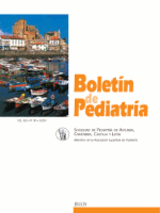Síndrome de megavejiga-microcolon-hipoperistaltismo intestinal
S. Suárez Saavedra , A. Calvo Gómez-Rodulfo , R. Quiroga González , M. Díaz , C. Moro Bayón , J.B. López Sastre
Bol. Pediatr. 2004; 44 (189): 161 - 165
El síndrome de megavejiga-microcolon-hipoperistaltismo intestinal es una causa rara, grave y congénita de obstrucción intestinal funcional neonatal que además puede llevar asociadas otras alteraciones. Actualmente sigue siendo difícil el diagnóstico prenatal de certeza y debe hacerse diagnóstico diferencial con problemas obstructivos. Al nacimiento se presenta con clínica de obstrucción intestinal y retención urinaria, precisando de pruebas complementarias para la confirmación diagnóstica. En el manejo de estos pacientes es fundamental el soporte nutricional que en muchas ocasiones se basa en nutrición parenteral durante largos periodos de tiempo. Apesar de la mejoría en la asistencia a estos pacientes, este síndrome sigue presentando una elevada morbilidad y mortalidad siendo el trasplante intestinal una alternativa terapéutica. Se presenta a continuación el caso de un paciente que actualmente tiene 6 meses y recibe nutrición enteral a débito continuo suplementada con nutrición parenteral domiciliaria con buena ganancia ponderal y aceptable calidadde vida. Abstract Megacystis-microcolon-intestinal hypoperistalsis syndrome is a rare, severe and congenital cause of functional intestinal obstruction in newborn that can have other abnormalities associated. Nowadays it is still difficult to make prenatal diagnosis and it should be differentiated from intestinal obstructions. This syndrome appears in early life like an intestinal obstruction and urine retention and it is necessary to make some studies to confirm the diagnosis. In these patients the nutritional support is very important and in a lot of cases this consists in long term parenteral nutrition. Despite of the advances in assistance, this syndrome has still a high morbidity and mortality and the intestinal transplantation should be considered as a therapeutic alternative. We describe a 6 months old patient who receives enteral and parenteral nutrition with an adequate growth and quality of life.
\N
\N
Artículo completo (PDF) (86 kb.)
- Neonatología
